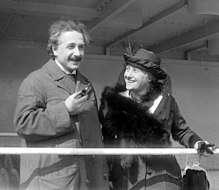Elsa Einstein
Elsa Einstein (18 January 1876 – 20 December 1936) was the second wife and cousin of Albert Einstein. Their mothers were sisters, making them maternal first cousins, and further, their fathers were first cousins, making them paternal second cousins. Elsa had the surname of Einstein at birth, lost it when she took the name of her first husband Max Löwenthal, and regained it in 1919 when she married her cousin Albert.
Elsa Einstein | |
|---|---|
 Elsa Einstein in 1929 | |
| Born | 18 January 1876 |
| Died | 20 December 1936 (aged 60) |
| Nationality | German |
| Known for | Being the second wife and cousin of Albert Einstein |
| Spouse(s) | Max Löwenthal (m. 1896; div. 1908) |
| Children | Ilse Lowenthal Einstein Margot Lowenthal Einstein |
| Parent(s) | Rudolf Einstein Fanny Koch Einstein |
| Relatives | Hermann Einstein (father-in-law; first cousin, once removed) |
| Family | Einstein |
Early life
Elsa, the daughter of Rudolf Einstein, was born in Hechingen in January 1876.[1] She had two sisters: Paula (c. 1878–c. 1955) and Hermine (1872–1942). Rudolf was a textile manufacturer in Hechingen. During the regular visits with the family in Munich, she often played with her cousin Albert. In her Swabian dialect, she called him "Albertle".[2] The two parted ways in 1894, when Albert left Germany to follow his family to Milan.
Married life
In 1896, Elsa married textile trader Max Löwenthal (1864–1914),[1] from Berlin, with whom she had three children: daughters Ilse (1897–1934) and Margot (1899-1986), and a son who was born in 1903, but died shortly after birth.[3] They lived together in Hechingen. In 1902, Max Löwenthal took a job in Berlin. His family stayed in Hechingen. She divorced Max on 11 May 1908,[1][2] and moved with her two daughters to an apartment above her parents on Haberlandstrasse[1] 5, in Berlin.[1]

She began a relationship with her cousin Albert Einstein in April 1912,[4] while Albert was still married to his first wife, the physicist Mileva Marić. Einstein separated from Mileva in 1914 and their divorce was final on 14 February 1919. Elsa married him three and a half months later, on June 2, 1919.[5]
Elsa's and Albert's mothers were sisters, which made Elsa and Albert maternal first cousins, and their fathers were first cousins.[2][6]
With stepdaughters Ilse and Margot, the Einsteins formed a close-knit family. Although Albert and Elsa did not have any children of their own, Albert raised Ilse and Margot as his own.[6] They lived in the Berlin area, also having a summer house in Caputh in nearby Potsdam.[7]
Elsa spent most of her marriage with Albert acting as his gatekeeper, protecting him from unwelcome visitors and charlatans.[8] She also was the driving force behind building their summer house in 1929.[2]
Later life
In 1933, Albert and Elsa Einstein immigrated to Princeton, New Jersey, US. In autumn 1935, they moved to a house at 112 Mercer Street,[9] bought that August,[2] but shortly afterwards Elsa developed a swollen eye and was diagnosed with heart and kidney problems.[9] When Elsa was diagnosed, Einstein decided to spend much of his time in his studies. It was stated in Walter Isaacson's book, Einstein: His Life and Universe, that he believed "strenuous intellectual work and looking at God's nature are the reconciling, fortifying yet relentlessly strict angels that shall lead me through all of life's troubles".[10] Thus did Einstein try to escape from his troubles by focusing on work that would distract him from Elsa's dying. Elsa died after a painful illness on December 20, 1936, in the house on Mercer Street.[9]
See also
- Albert Einstein House Princeton
- Genius, a television series depicting the Einsteins
- List of coupled cousins
Citations
- Highfield 1993, p. 146
- Short life history: Elsa Einstein.
- Highfield 1993, p. 146,287
- Highfield 1993, p. 147
- The Guardian
- Highfield 1993, p. 193
- Highfield 1993, p. 203
- Highfield 1993, p. 190,196
- Highfield 1993, p. 216
- Isaacson, Walter (2008). Einstein: His life and Universe. Simon and Schuster.
References
- Highfield, Roger; Carter, Paul (1993), The Private Lives of Albert Einstein, London: Faber and Faber, ISBN 0-571-17170-2